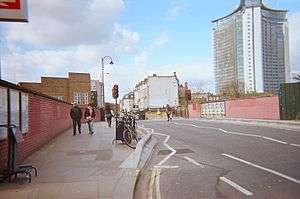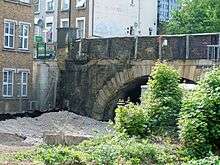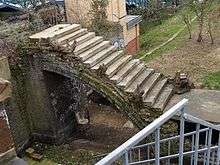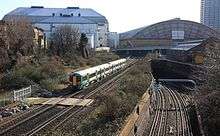Lillie Bridge (Fulham)
Lillie Bridge is a road bridge that links Old Brompton Road in the Royal Borough of Kensington and Chelsea with Lillie Road in the London Borough of Hammersmith & Fulham. It crosses two railways: the West London Line on the London Overground and the Wimbledon branch of the London Underground at West Brompton station.
Lillie Bridge | |
|---|---|
 Lillie Bridge from West Brompton station | |
| Coordinates | 51°29′N 0°12′W |
| Carries | A3218 road |
| Crosses | West London Line |
| Locale | London, England, United Kingdom |
| Characteristics | |
| Design | Road bridge |
| Material | steel and brick |
| History | |
| Designer | Sir John Fowler, 1st Baronet |
| Opened | 1860 |
%26groups%3D_80a10dcaf917eece5cd096c67b28f6a186821ed1.svg)
| |

History
Its history goes back to at least the 18th-century when there was a wooden foot-bridge, called 'Gunter's Bridge' after landowner and confectioner James Gunter (1731-1819), over a tributary of the River Thames, variously called Counter's Creek, or Counter's ditch (or sewer), that separated the parishes of Fulham and Kensington at this spot.[1] A Magistrates' enquiry into the bridges of the County of Middlesex, set up in 1820, described it thus:
Footbridge of Wood called Gunter's Bridge in the Footpath between Earls Court and Walham Green. [...] This bridge has been built upwards of Fifty Years and is kept in repair at the joint expense of Kensington and Fulham Parishes. [...] The tide flows to a considerable distance above this Bridge.[2]
A stone and brick structure was built in its place, when Counter's Creek was converted into the Kensington Canal in 1826.[3] It opened for trade in 1828. Remnants of the bridge beneath the current road bridge are still visible from platform 4 on the Overground Line at the neighbouring station. The new bridge was subsequently named after Sir John Scott Lillie, the Peninsular War veteran and inventor and early 19th-century developer on the Fulham side, who was also involved with the canal project. Its railway associations go back to 1838 under the supervision of engineer, Robert Stephenson. The canal bridge was used to carry the road over the railway to the London and North Western Railway yard which had replaced the canal basin and wharves behind Reckitt Street, Fulham.[4]


A new much enlarged road bridge was built over the stone and brick canal crossing in 1860 by the railway engineer, John Fowler in connection with his construction of the Grade II Listed West Brompton station.[5][6] Since then. the bridge became known for the sporting venues to the south, as the 'Lillie Bridge Grounds' opened in 1869 and closed by arson and a riot in 1887.[7] It was the scene of athletics, football and county cricket, as well as cycling and ballooning. To the north it has become associated with the eponymous Lillie Bridge Depot, built in 1871 as an engineering hub for the early railways and latterly, a maintenance centre for London Transport's tube network.[8] Fowler's bridge has been lengthened and strengthened in ensuing years. The brickwork in the original parapets has been repaired but the four stone plaques commemorating the dates of re-building, from 1860 onwards, are retained in the present bridge. Both parapets were obscured for decades by tall advertising hoardings only taken down since 2012 for the Olympic Games, when Indoor volleyball was played at Earl's Court.[9]
Green corridor
In spite of repeated disturbance since the early 19th-century, with canal and railway building, the verges of the West London Line and the proximity of Brompton Cemetery and the town gardens of Empress Place in Fulham, had ensured the survival of a rich biodiversity in the area of the bridge. Most notably there is a pond, remnant of the ever-present Counter's Creek, along platform 4 of West Brompton station on the Fulham side. The pond and its acre of 'scrub' was, until 5 years ago, supervised by the erstwhile Railtrack and local volunteers from Fulham Groundwork UK. The defunct London Ecology Unit produced in 1993 an audit of the flora and fauna to be found here. There are said to have been 140 species of flora.[10] In 2016 the Bee Friendly Trust installed on platform 2 of the District line at West Brompton station, a number of flower boxes to attract pollinating insects.
Future prospects
Lillie Bridge, along with the borough boundary, the natural 'Green corridor' and built heritage, are scheduled to disappear in the regeneration plans for the Earls Court Exhibition Centre site.[11]
References
- Barton, Nicholas. (1962 and 1992). The Lost Rivers of London, London: Historical Publications, ISBN 0 948667 15 X. p. 71
- Report of the Committee of Magistrates appointed (26th October 1820) to make enquiry respecting the Public Bridges in the County of Middlesex. London: printed by J. Rider, Little Britain, 1826. See page 187 for Counter's Creek (Sewer). https://books.google.co.uk/books?id=jaFfAAAAcAAJ&dq=James+Gunter%27s+footbridge&source=gbs_navlinks_s accessed 2016-10-12
- Survey of London-The Kensington Canal, railways and related developments; http://www.british-history.ac.uk/survey-london/vol42/pp322-338#fn6
- Mitchell, V. and Smith, K. (1996). West London Line - Clapham Jn. to Willesden Jn.. Midhurst: Middleton Press. ISBN 1 873793 84 7 Fig. 43 shows a 1957 photograph, by D. Clayton, of the original stone canal bridge arch next to the bomb-damaged West Brompton station.
- "Underground London: Its railways, subways and sewers - British History Online".
- "The Kensington Canal, railways and related developments - British History Online".
- Denny, Barbara (1997). Fulham Past. London: Historical Publications. p. 126. ISBN 0 948667 43 5.
- Route and Track diagrams for West Kensington and Lillie Bridge: http://www.trainweb.org/tubeprune/route%20and%20track%20diagrams.htm#West%20Kensington%20and%20Lillie%20Bridge retrieved 2016-10-03
- London2012.com profile. Archived 2 October 2011 at the Wayback Machine – accessed 29 September 2010.
- Nature Conservation in Hammersmith & Fulham - Issue 25 of Ecology handbook. Publisher: London Ecology Unit, 1993 ISBN 1871045223, 9781871045222 - 72 pages
- Hill, Dave (26 November 2012). "Earls Court: Kensington and Chelsea's go ahead can't hide the contradictions | Politics". theguardian.com. Retrieved 15 January 2014.
Gallery
 1860 stone plaque on Lillie Bridge, Fulham
1860 stone plaque on Lillie Bridge, Fulham On the right, Lillie Bridge obscured by advertising hoardings in 1963
On the right, Lillie Bridge obscured by advertising hoardings in 1963 The West London Line passing under Lillie Bridge towards Kensington (Olympia) station
The West London Line passing under Lillie Bridge towards Kensington (Olympia) station Lillie Bridge Depot shed to the right against Earls Court Exhibition Centre
Lillie Bridge Depot shed to the right against Earls Court Exhibition Centre View from Lillie Bridge onto Earls Court II demolition site, 2015
View from Lillie Bridge onto Earls Court II demolition site, 2015 Wrestling at Lillie Bridge Grounds in 1879
Wrestling at Lillie Bridge Grounds in 1879- Tree Canopy behind Empress Place viewed from Lillie Bridge
 Green corridor along West London Line from Lillie Bridge
Green corridor along West London Line from Lillie Bridge North parapet brickwork on Lillie Bridge 2016
North parapet brickwork on Lillie Bridge 2016 1865 plaque on north parapet of Lillie Bridge
1865 plaque on north parapet of Lillie Bridge remnant of Counter's Creek at West Brompton station, Fulham
remnant of Counter's Creek at West Brompton station, Fulham